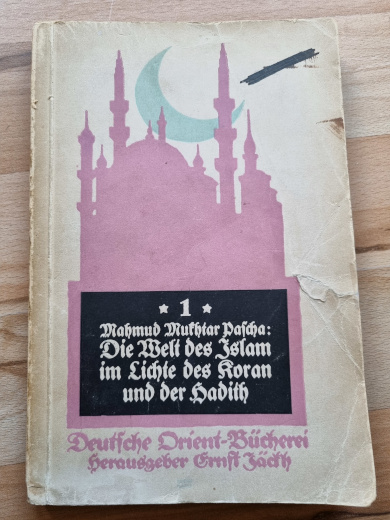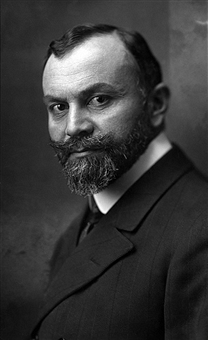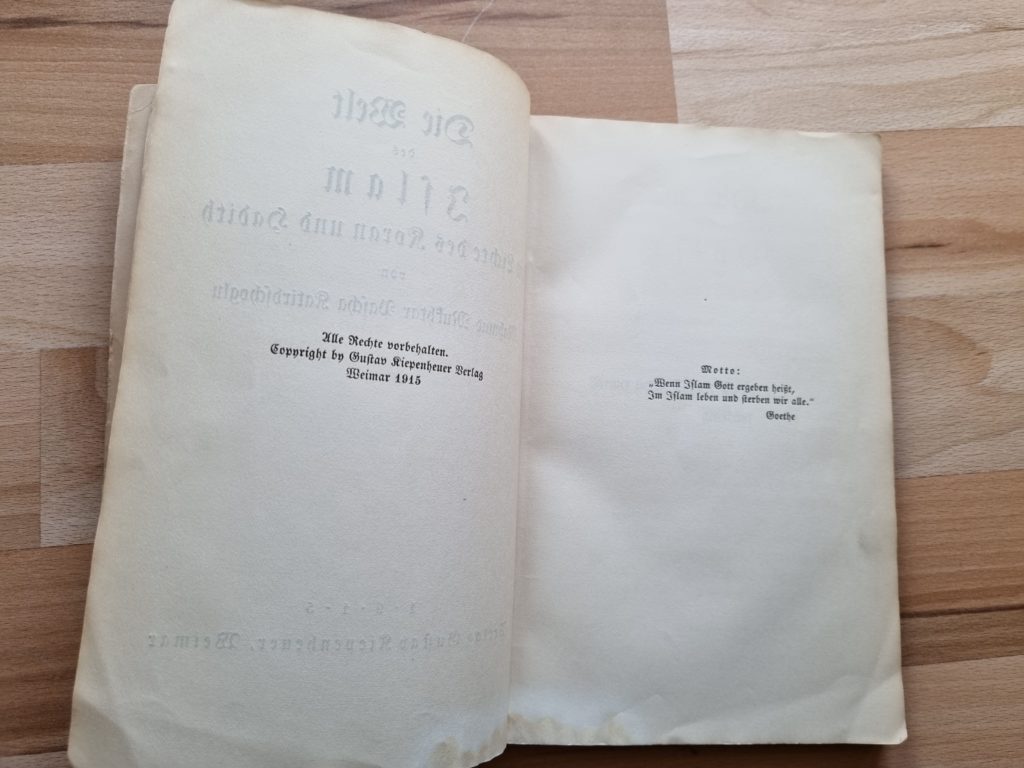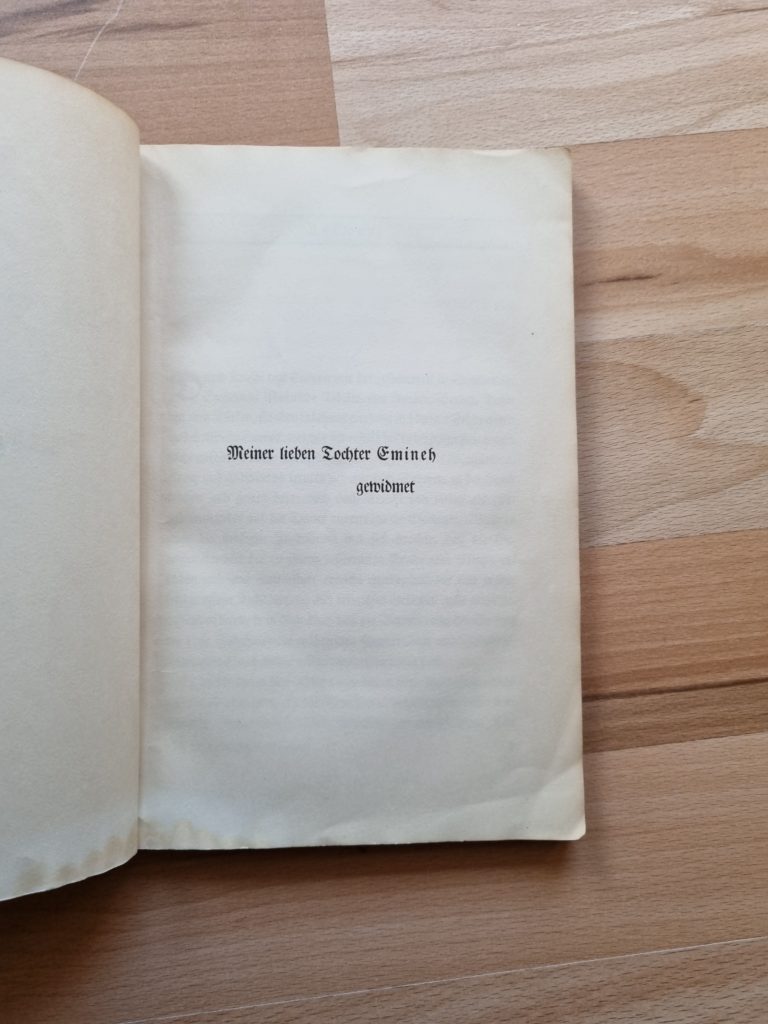Qur’an translation as propaganda: war alliances and nation-building (1/3)
When the Ottoman Empire entered the First World War in November 1914 on the side of Germany and Austria-Hungary, pro-Ottoman circles in Germany were eager to sell this new alliance to a German-speaking public that was under the influence of decades of discourses on Oriental despotism and backwardness. The new pro-Ottoman propaganda effort meant it was necessary to portray Islam as a religion that was neither incompatible with modernity nor inherently hostile to non-Muslims.
It was against this background that, in 1915, Mahmud Mukhtar Pasha (1867–1935; in modern Turkish spelling, Mahmut Muhtar Paşa), the then Ottoman ambassador in Berlin, published an inexpensive German softcover book entitled “The World of Islam in the Light of the Qur’an and the Hadith” (“Die Welt des Islam im Lichte des Koran und der Hadith”), in response to a request from German supporters of the German-Ottoman alliance. At the core of the book were translations of approximately 400 verses from the Qur’an, arranged in thematic sections, complemented by hadiths and a wide variety of other material.
This was no lacklustre effort. A deeply pious man, Mahmud Mukhtar (who later adopted the last name of his family dynasty, Katırcıoğlu) translated the Qur’anic verses himself, without drawing on existing German Qur’an translations. He was able to do so because he had spent many years training in German military schools and was therefore fluent in German – and he undertook to do so at a time when the notion of Qur’an translation was still fiercely contested in the Ottoman Empire.
Mahmud Mukhtar was from a family of Ottoman notables, and was married to Nimet Hanım, a daughter of the Egyptian Khedive İsmail. He was a high-ranking general in the Ottoman army and was twice appointed Minister of Navy, a post he only held for short periods. While loyal to the Ottoman Empire, he was less enamoured with the nationalist ambitions of the Young Turks and frequently found himself at odds with their policies, which lent considerable turbulence to his career. At the time the Ottoman Empire entered the war, he had already served as ambassador to the German Reich for a year and a half. He obviously readily responded to the request to provide the German public with a book about Islam, as he seems to have produced it in only a few months.
The request probably came from Ernst Jäckh (1875–1959), an enthusiastic promoter of German efforts to increase the country’s influence in “the Orient”, by which he mainly meant the Ottoman Empire. Jäckh believed that the Caliph’s declaration of jihad was going to incite Muslims across the world to war against their British and French oppressors and was keen to mobilize Arabs, in particular, against Britain and France. He was, among many other functions, the managing director of the German-Turkish Association, of which Mahmud Mukhtar was an honorary member; the general editor of the “German Oriental Library (“Deutsche Orientbücherei”), in which Mahmud Mukhtar’s book was published as the first volume; the author of “The Rising Crescent: On the Way to a German-Turkish Alliance”, which described the Ottoman Empire as a potential market for German industrial products and provider of raw materials; the co-editor of a weekly journal called “The Greater Germany” that promoted Germany’s aspirations to become a global and colonial power; and, last but not least, the editor of a series of political pamphlets entitled “The German War”.
Given the context, and Mahmud Mukhtar’s own military training, his book on Islam devotes surprisingly little attention to matters of war. The opening motto is a quote from a poem by Goethe and sets quite a different tone: “If Islam means devotion to God, in Islam we all live and die.”
It is mainly through the brief foreword and afterword that Mahmud Mukhtar situates the book in the context of the German-Ottoman war alliance. In the foreword, he argues that religious believers should overcome their strife and aim for conciliation. “The present time,” he continued, “appears to be particularly suitable for this, given that two of the strongest Christian powers are waging a war, in an alliance with the Ottoman Empire, against common enemies, and that the entire Islamic world sees its future in the achievements of the weapons of these Christian empires. Since the Caliph identified the enemies of Germany and Austria-Hungary as enemies of Islam as a whole, this created such bonds of friendship and common interest between these two empires and Islamic countries that necessitate an intimate mutual understanding in all areas in order to uphold and intensify these valuable relations in the future.” (If the English translation seems awkward, this is because the author was sometimes caught up in the syntax of his long-winded German sentences.)
The afterword closes in similar vein: “May the new era that is dawning through the loyal brotherhood in arms of the caliphal Empire with two great Christian nations for the protection of their freedom, culture and distinctive character guarantee continuous feelings of true brotherhood even in times of peace, and may closely joint progress in the ordained paths of providence lead towards salvation and victory for all times. May God grant that.” (Yes, his original German sentences are this long and convoluted!)
These perfunctory references to the Great War aside, however, the book gives the impression that the author was predominantly driven by an ideal of religious unity according to which all religions have the same aims, namely, belief in God, the moral advancement of human individuals and societies, and mutual love between humans. In order to achieve that goal, God has periodically renewed His prophecy without altering the fundamental message. Given this conviction, Mahmud Mukhtar’s aim is to foster mutual understanding between Christians and Muslims by providing German readers with information on Islam from an authentic Muslim perspective, correcting prevailing misconceptions and emphasizing the common ground between Christianity and Islam. He aims, in his own words, “to clarify that, if religion has the purpose to promote love and mercy towards one’s fellow humans as well as raising awareness of the one God, Islam is eminently well-suited to fulfil that purpose.”
The role of the Qur’an in this endeavour is to provide direct access to the authentic, uncorrupted source of religion, untainted by fallible human interpretations. The fact that translation itself might be an act of human interpretation is not addressed here. Mahmud Mukhtar believed in individual Muslims’ freedom to interpret the Qur’an in different ways but also affirmed the necessity of a (Sunni) orthodoxy that should prevent excesses.
His book is a rich source that contains not only his Qur’an translations, but also an abundance of other material. This includes hadiths that the author mostly took from a contemporary Ottoman hadith collection, poems by Rumi, Hafiz and ʿUmar Khayyam as well as German romanticists, references to al-Ghazali and Ibn ʿArabi, whom Mahmud Mukhtar much revered, and many quotations from the works of German Orientalists and travellers to the Middle East. This thread will focus on his Qur’an translations. (For readers of Turkish, Mahmud Mukhtar’s book has been more comprehensively discussed by Sabri Çap: https://www.academia.edu/41212470/Mahmut_Muhtar_Pa%C5%9Fa_n%C4%B1n_1867_1935_Kur_an_ve_Hadisle_%C4%B0lgili_%C4%B0ki_Eseri_%C3%9Czerine.)
Mahmud Mukhtar’s Qur’an translations are based on the Istanbul edition by Osman Zeki Bey, a friend of Sultan Abdülhamit II who, in 1880, received a concession for muṣḥaf-printing in the Ottoman Empire that guaranteed him a legal monopoly for nearly 30 years. From this edition, Mahmud Mukhar selected 320 segments that contain approximately 400 verses, which he arranged in thematic chapters.
At the time Mahmud Mukhtar wrote his book, thematically arranged translations of selected verses from the Qur’an, sometimes supplemented by explanations or additional material, were a fashionable way of introducing Islam to European readers, and there are several other examples of such works in German, French and English. This was a pragmatic choice because this format was more easily digestible for readers and was far less time-consuming to write than would have been the case for a full Qur’an translation. It also allowed translators to focus on topics that they considered important and to play down topics that they thought might alienate their readers.
For Mahmud Mukhtar, this selectiveness is not only a pragmatic but also an ideologically valid choice. He argues that “not everything that is contained in the Qur’an is of equal value and permanent relevance.” With reference to Q 2:106, he points to the principle of abrogation (naskh), according to which some verses of the Qur’an may supersede others, and concludes: “Those parts of the Qur’an are permanently valid and authoritative that point to the eternal, unchangeable principles that all religions believe exclusively lead to salvation and bliss, and out of which a powerful voice resounds: Peace and love, forgiveness and mercy.”
Mahmud Mukhtar’s vision of the topics that have “permanent relevance” is reflected in the structure of his book. He arranged his material in twenty chapters, sixteen of which deal with issues of faith and religious ritual. The remaining four are entitled “Holy War (Djihad)”, “Marriage and Women”, “State and Society”, and “Islam as an Element of Culture”. All chapters except for the last one start with verses from the Qur’an. Whereas hadiths are optional, the Qur’an is ubiquitous. The last chapter, “Islam as an element of culture”, is void of Qur’anic references because it is mostly intended to refute the then-common association between Islam and backwardness. Here, Mahmud Mukhtar wants to show that none of the perceived or real backwardness of Islam is rooted in the Qur’an. Rather, he considers it to be a result of historical developments, particularly the excessive influence of the ulama. According to him, Islam in its original, authentic sense allows for the clear separation between the religious and secular spheres and does not demand that all laws governing human societies be governed by religious parameters or controlled by clerics.
Mahmud Mukhtar’s selection, arrangement and translation of verses seem to be governed by two major factors.
The first factor is the author’s own religious formation. Mahmud Mukhtar’s affinity to Sufism – quite typical for an Ottoman citizen of his times – becomes clear in the chapter entitled “Dervishes” in which he describes the Sufi way in highly sympathetic terms that match his general emphasis on divine love.
Sufism aside, he clearly reads the Qur’an from the perspective of the Sunni tradition. For example, he unambiguously ascribes to Abū Bakr a prayer in the Qur’an (Q 46:15) that the text attributes to humans (al-insān) in general (which may indicate his use of the “Tafsīr al-Jalālayn”). He furthermore includes a chapter on predestination in which he affirms belief in predestination as an obligatory article of faith – an argument that is somewhat complicated by his desire to counter the idea that Islam endorses fatalism.
His translation of the Throne Verse (āyat al-kursī, Q 2:255) is particularly revealing. The phrase
وَسِعَ كُرْسِيُّهُ السَّمَاوَاتِ وَالْأَرْضَ
could be rendered as “His throne encompasses the heavens and the earth”, but Mahmud Mukhtar translates it as “His divine doing encompasses the heavens and the earth” (“Sein göttliches Tun umfaßt die Himmel und die Erde”), a reading that is clearly in line with the dominant anti-anthropomorphic trend in Sunni theology.
In other instances, he opts for a rendering of verses that involve God’s throne in an equally metaphorical but quite different manner. For example, he renders Q 13:2
ثُمَّ اسْتَوَىٰ عَلَى الْعَرْشِ
which could literally be understood to mean “Then He established Himself on the throne”, as “Then He brought balance to the universe” (“Dann brachte er Gleichgewicht in das Universum”); a similar interpretation is given for Q 32:4. This occurs in the context of the chapter on creation in which he highlights the scientific accuracy of the Qur’an, much in line with a modernist trend that was at the time particularly visible in Egypt. To give an example of such scientific interpretations: according to Mahmud Mukhtar, “some” think that Q 91:6
وَٱلْأَرْضِ وَمَا طَحَىٰهَا
should not be read as “By the earth and Him who spread it!”, which would indicate a flat earth, but as “By the earth and Him, who flattened it (its poles)!”, pointing to accurate scientific knowledge. He also explicitly affirms the compatibility between Islam and the theory of evolution. All in all, the ideas he expresses in the chapter on creation, while in line with a certain zeitgeist among progressive Muslim intellectuals, are highly original and might be partly of his own making.
The influence that modernist ideas exerted on Mahmud Mukhtar is closely connected to the second factor that governed his selections from and translation of the Qur’an, namely, the desire to describe Islam, as far as possible, as compatible with Christianity, and with the social and moral expectations of a German readership. Accordingly, the chapter devoted to Jesus is among the longest in the book, and the chapter on “Islamic morality” is clearly *the*longest.
The main goal in these chapters is to emphasize the degree to which Islam promotes individual and social morals, to minimize points of conflict between Islam and Christianity and to deflect widespread accusations against Islam. For example, Mahmud Mukhtar discusses Q 4:157, which deals with the crucifixion of Jesus, at length. The verse seems to imply that Jesus was not crucified, although God made it appear to his enemies as if he had. However, according to Mahmud Mukhtar, the verse’s denial of Jesus’ crucifixion can be interpreted in a metaphorical manner. He admits that the exegetical tradition is fairly unanimous in rejecting Jesus’ death on the cross but argues that the Qur’anic commentaries are not authoritative and that the Qur’an allows for a different interpretation. The real point of conflict between Islam and Christianity, he states, is not the issue of crucifixion but the Christian belief in salvation through Jesus’ suffering and death, which has no basis in the Qur’an. He points to further areas of disagreement, such as the Christian belief in hereditary sin, in the salvific power of the church and, of course, in the doctrine of the Trinity. All in all, however, he makes an effort to emphasize the affinity between Christianity and Islam, which he sometimes achieves by blaming the church and the ulama for developments in either religion that run counter to its original nature, and sometimes by suggesting that innovations such as the prohibition of interest and of paintings and sculptures were introduced by the Jews. While not outright hostile, the author’s attitude towards Judaism is definitely more reserved than that towards Christianity.
Mahmud Mukhtar also keeps an eye on ways he can make his material easy to digest for Christians. For example, he has chapters on prayer and pilgrimage, but not on zakāt and fasting. He points out that the ban on alcohol has always been less strictly followed than the ban on pork. Moreover, he sometimes opts for specifically Christian vocabulary in his translations. For example, he calls the Sufi orders “monastic orders”, and translates the injunction “iqraʾ”in Q 96:1 as “Preach!” (“Predige!”) rather than the more common “Recite!” or “Read!”.
Topics that featured prominently in European polemics against Islam receive considerable attention, especially jihad, gender relations and slavery.
Regarding jihad, Mahmud Mukhtar aims to demonstrate, based on copious quotations from the Qur’an, that war is almost exclusively allowed for defensive purposes and that Muslims are obliged to coexist peacefully with non-Muslims. Within these parameters, he appears to accept the existence of war as a fact of life and, in line with the predominant mood of the time, believes it to be important to prepare youths, and particularly male youths, for it: “It is a part of Islamic education to make young men fit for war”; “Every Muslim should be physically equipped for the legitimate fight for survival.”
He also argues that the Islamic laws of war are fully compatible with the modern law of nations:
“Respect for treaties and peaceful coexistence with civilized nations (the People of the Book) are established as norms. Only with regard to heathen peoples – namely, those who live a life without purpose and law – did it become a duty of the Islamic state to lead them towards God and duty. This principle is in line with the consequences of modern colonial wars.”
At the same time, Mahmud Mukhtar maintains that many concepts from the Qur’an and Islamic law that relate to war, such as the notion of “the Abode of War” (dār al-ḥarb), had a limited purpose and have become obsolete in the modern era. The same, he says, is true of slavery, which was only ever practiced by Muslims in the mildest and most benevolent manner imaginable.
His approach towards gender relations is somewhat similar: he emphasizes the rights of women and defends the practice of polygamy with regard to early Islam but declares it to be practically obsolete in the contemporary period. Interestingly, Mahmud Mukhtar cites the controversial “wife-beating verse” (Q 4:34) to substantiate his argument that the Qur’an, like the Bible, has pragmatic reasons to favour men over women: “Men are superior to women.” He omits, however, the last part of the verse that was in his time unanimously understood to give a husband the right to physically chastise his wife. Instead, he cites a hadith that prohibits men from beating women.
The only instance where Mahmud Mukhtar does not quite follow his usual strategy of demonstrating Islam’s adaptability to European social norms but rather implies that Islamic norms might actually be superior to European customs concerns the practices of veiling and segregation:
“We must firmly argue in favour of the withdrawn way of life of Muhammadan ladies, which is rather more limited to home and family, as opposed to the free and unrestricted education of the female sex as it is commonly practiced in the Occident, leading to the dominance of that sex in the entire public life against its natural purpose. For it needs no further reasoning to show that an education towards piety and industriousness, even if it might appear to us somewhat limited according to our European ideas, is preferable to the aforementioned free and unrestricted one, which quite frequently basically consists of all kinds of pretences, the reading of novels of manners and the attendance of pleasurable events and festivities of doubtful value. The custom of covering up or veiling which is prescribed to Muhammadan ladies in public by Quran 24:31 does certainly have its merits.”
His interest in social and political matters is limited, however. Regarding politics, he perfunctorily quotes two verses to make the point that the Qur’an supports constitutionalism, based on the notion of shūrā(Q 42:38), but also accepts hierarchies (Q 43:32). All in all, he clearly sees the main purpose of Islam as residing in matters of faith and ethics.
This view is also reflected in one of Mahmud Muktar’s later works, “La Sagesse Coranique”, a collection of Qur’anic verses translated into French that was published posthumously in 1935 at the behest of his wife, and was also translated into English as “The Wisdom of the Qur’an”. When he wrote it, Mahmud Mukhtar was living in exile between Alexandria and Europe. He had left Turkey in 1917 after having fallen out with Enver Pasha, never to return. Free of official functions and editorial demands, he was able to focus on his religious interests, primarily Sufism.
In “La Sagesse Coranique”, published twenty years after his German work on Islam, Mahmud Mukhtar did not arrange verses thematically, but presented them sura by sura, without interfering with the canonical arrangement of the Qur’an. The result clearly shows where his preferences lie. He gives vastly more space to suras that focus on metaphysical imagery (e.g., Q 53), the relationship between God and mankind (e.g., Q 42) or the promises of heavenly rewards to believers (e.g., Q 36) than on suras that discuss war (Q 8 and 9 receive little more than half a page each). When we compare “La Sagesse Coranique” with Mahmud Mukhtar’s earlier German work, we can see to what extent “Die Welt des Islam im Lichte des Koran und der Hadith” might have been a compromise between the author’s personal piety and the demands of war propaganda.
Johanna Pink













